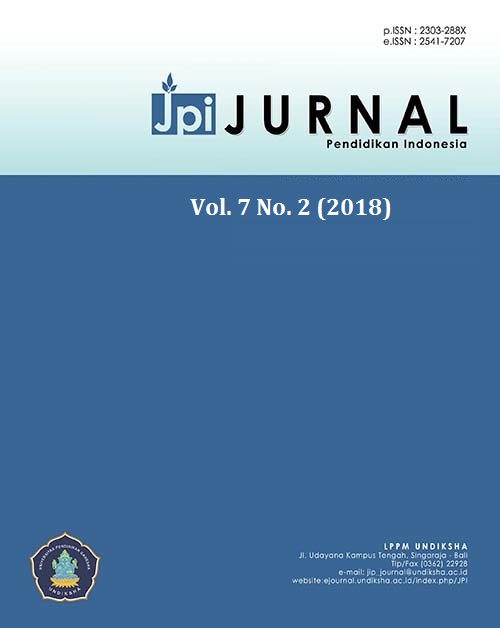Judges Analysis of Infographic Media Research Methodology
DOI:
https://doi.org/10.23887/jpi-undiksha.v7i2.16134Keywords:
Methodology, Video, Infographic AnimationAbstract
This study aimed to design and implement the results of the video design of SOP Types - Types of Research for Lecture Research Methodology Based on Infographic Animation. The development of this video aimed to provide information about the Standard Operating Procedure (SOP) Research to all academics who are studying educational research methodology. The method used was research and development. The model used in building this technology was the ADDIE Model. The stages in the ADDIE model are Analysis (analysis), Design (design), Development (development), Implementation (implementation), and Evaluation (evaluation). The final result of this project is in the form of an animated video containing several Standard Operating Procedure (SOP) that have been selected to create animated videos. This animated video can display animation in 2 dimensions. This animated video can also be used as a medium for delivering information to be more interesting. However, this article only discussed the results of expert test analysis, which includes: analysis of content experts and analysis media experts.
References
Adiputra, S. (2014). Pengembangan E-Modul Pada Materi “Melakukan Instalasi Sistem Operasi Jaringan Berbasis Gui Dan Text” Untuk Siswa Kelas X Teknik Komputer Dan Jaringan. Singaraja: Universitas Pendidikan Ganesha.
Ahadi. (2012). Pengertian ilmu pengetahuan adalah. Retrieved from ilmu sipil: (http://www.ilmusipil.com/pengertian-ilmu-pengetahuan-adalah)
Candiasa. M. (2010). Pengujian Instrumen Penelitian Disertai Aplikasi Iteman dan Bigsteps. Singaraja: Universitas Pendidikan Ganesha.
Suhara, A. M. (2013). Keefektifan model VAK Dalam Pembelajaran Menulis Deskriptif. Bandung: Universitas Pendidikan Indonesia.
Sukardi. (2003). Metodologi Penelitian Pendidikan. Yogyakarta: PT. Bumi Aksara.
Pahlevi, A. S. (2013). perancangan aplikasi infografis dalam kampanye sosial untuk mendukung aktivitas corporate social responsibility de tanjung. Yogyakarta: Institut Seni Indonesia.
Arinata, A. (2016). Perancangan Video Infografis Animasi Interaktif tentang Prosedur Pemberangkatan Tenaga Kerja Indonesia Berbasis Android. Jurnal Teknik Informatika dan Sistem Informasi., 365-375.
Sastrawan, P.V.,Arthana, I.K.R., Sindu, I.G.P(2017). Pengembangan SOP Fakultas Teknik dan Kejuruan Universitas Pendidikan Ganesha Berbasis Animasi. Jurnal Pendidikan Teknik Informatika(Karmapati), Vol 6, No 1.
Umami, Muhammad Rizza dan Suryadi, Ashadi. 2016. Pengaruh Media Infografis Dan Poster Pada Pembelajaran Joyful Learning Terhadap Prestasi Belajar Siswa Ditinjau Dari Kemampuan Logika Pada Materi Pokok Kesetimbangan Kimia Kelas Xi Ipa Semester Gasal Sma Negeri Gondangrejo Tahun Pelajaran 2015/2016. http://jurnal.fkip.uns.ac.id/index.php/kimia/article/view/8491 Jurnal Pendidikan Kimia Vol 5, no 3, 2016.
Handani, S W, Shima Umami, dan Dinar Kusmira. Visualisasi Pencemaran Air Menggunakan Media Animasi Infografis. Jurnal Telematika Volume 10, No 1. http://ejournal.amikompurwokerto.ac.id/index.php/telematika/article/view/499/400
Downloads
Published
Issue
Section
License
Authors who publish with the Jurnal Pendidikan Indnesia agree to the following terms:
- Authors retain copyright and grant the journal the right of first publication with the work simultaneously licensed under a Creative Commons Attribution License (CC BY-SA 4.0) that allows others to share the work with an acknowledgment of the work's authorship and initial publication in this journal.
- Authors are able to enter into separate, additional contractual arrangements for the non-exclusive distribution of the journal's published version of the work (e.g., post it to an institutional repository or publish it in a book), with an acknowledgment of its initial publication in this journal.
- Authors are permitted and encouraged to post their work online (e.g., in institutional repositories or on their website) prior to and during the submission process, as it can lead to productive exchanges, as well as earlier and greater citation of published work. (See The Effect of Open Access)








